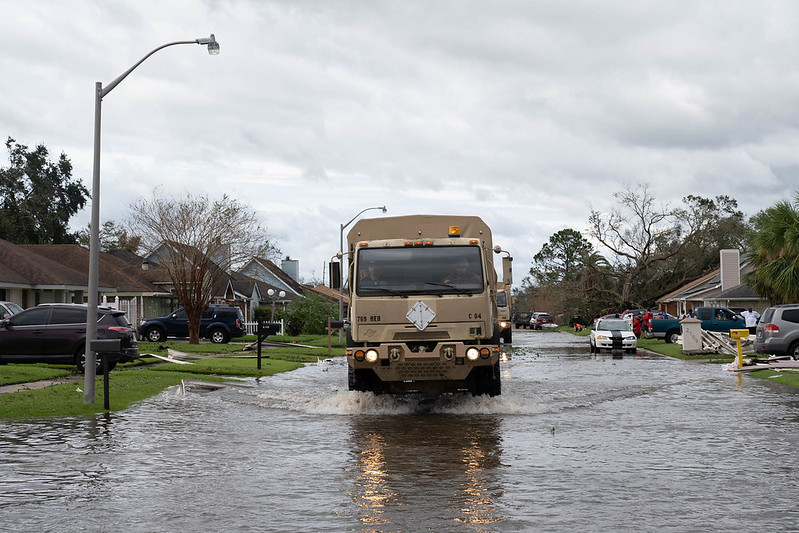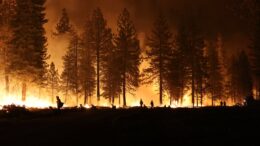Talent. King Mountain. Hugo. The town names — each the site of new wildfire ignitions following a lightning storm the day before — are all new to me. After I read each incident report, I head to Google maps to ask the same question that’s been on my mind for weeks: How close?
This is my first wildfire season — also known as summer — in my new home state of Oregon. I’m learning the geography by way of (potential) catastrophe.
After nearly two decades in San Francisco, my wife and I moved to central Oregon in May. We had been plotting our escape to a more rural location for years. While climate change wasn’t our reason for leaving the Bay Area, it was a consideration in where to go next.
We first looked at towns along the east and west flanks of California’s Sierra Nevada. But our searches mostly ended in frustration … and a bit of fear. We’d hear from locals about getting dropped from their fire insurance or the skyrocketing costs of keeping their policies. And then there were the actual wildfires — like the ones that reduced large swathes of Paradise, and now Greenville, to ash.
When we eventually settled on central Oregon as our next home, we were under no illusion that it would be free from wildfires: I’m an environmental journalist who covers fires and climate change as part of my beat. Wildfire risk, we knew, would come with our new territory.
And it has. As I write this, ash from multiple fires burning in the region dusts my patio furniture. Cascade peaks, usually visible on the horizon, have been smudged by smoke. The air quality has once again reached unhealthy levels.
Still, there are numerous reasons we’re glad to be here, even if we do have occasional pangs of doubt and wonder why we didn’t move out of the West entirely — out of the path of increasingly longer fire seasons.
Around the country, other families find themselves in similar situations, or may soon. As this summer so cruelly illuminates, climate change will present a barrage of challenges — including droughts, floods and hurricanes — no matter where you live.

Understanding the risks of different places isn’t easy. As we contemplated our move, I dug through state climate assessments and read scientific reports. But it was hard to match general findings with specific places, even for someone like me who gets paid to do that kind of stuff. Most people don’t have hours to read journal articles and try to decipher scientific lingo.
That got me thinking: Whether moving or staying put, how do we assess risk in a climate change world?
Where To?
Last summer the San Francisco Bay Area had a day when the sun never seemed to rise. The sky remained a darkened, calamitous gray-orange from morning till night as the August Complex fire burned, eventually scorching a record-breaking 1 million acres. I received more than a few texts from friends asking if it was time to move somewhere less “apocalyptic.” Was there a safer place to live in the coming years and decades as the planet continues to heat up?
It’s a question on a lot of people’s minds. The real estate website Redfin reports that the increasing frequency and intensity of natural disasters and extreme heat are factors in plans for about half of people considering moves in the next year.
Where to go may be a popular question, but it’s also a hard one to answer for a number of reasons, says Daniel Swain, a climate scientist at UCLA who gets asked that question multiple times a day.
“I don’t know what people’s motivations are, what their priorities are and what their lives are like,” he says. “It’s so personalized and individualized.”
The scientific factors, he says, are equally complex. For example, the difference between living somewhere with an extreme fire risk and a place with very little could be just a few miles in places like Los Angeles, he says.
And this summer has already shown that climate change is going to bring surprises.
“Most folks would have thought that Seattle or Portland would have been great places to escape extreme heat waves,” he says. “Well, clearly, that’s not always going to be the case. Seeing Death Valley-like temperatures in British Columbia in June, I think, really gave people pause. Climate projections suggest that all of these things and more are possible in the future, but I think it’s a particularly visceral recent example of how things are changing pretty fast.”
Climate change is likely to throw us other curveballs, too.
While most people are concerned with drought and fire in California, Swain says he’s more worried about how the state will handle the extreme flood risks that will also come with a warming climate.
“A lot of the risks, the physical hazards that are relevant in a changing climate, are not going to be obvious, and they’re not often going to be the ones that people are really hyper-focused on in a particular region,” he says. “What comes out of the woodwork in 10 or 20 years won’t necessarily be the same problems in the same places that we’re facing right now.”
Understanding the Science
So given what we know — and don’t — how do we go about figuring out where might be safe?
Historically, there haven’t been a lot of great resources to tap. Most climate models aren’t accessible to the general public. Or their raw data is taken out of context by others when trying to convey more localized impacts, which can be misleading, says Swain.
“I think a good example of this is California, where most of the state, according to climate models, is expected to see neither more nor less mean precipitation in the future with a few degrees of mean warming,” he explains. “And if you look at all of these downscaled products, it’ll say ‘great news, your water availability isn’t going to change,’ which of course is completely wrong for a variety of reasons.”
One reason is that rising temperatures will ensure that even if total precipitation doesn’t change, there will still be less available water supply because there’ll be more evaporation and thirstier soil, diminishing runoff.
But even a small change in annual average precipitation doesn’t catch the variability that California’s likely to experience with more extreme storm events and more droughts.
“So you get more really wet periods, but also more really dry periods,” says Swain. “In practical terms, it’s a really dramatic change. And so you might get a very inaccurate picture of what the future holds if you look at the wrong variables in the wrong context, even if the information is technically correct.”
Emerging Tools
So how do we find the right information in the right context? There are some new efforts attempting just that.
Redfin, for example, recently partnered with ClimateCheck to add a feature to their listings that provides the future climate risk of a particular property. It assesses the change in the risk of heat, fire, drought and storms over the next 30 years.
(EXCLUSIVE)
There are signs that more Americans may be starting to weigh climate -related risks when purchasing a home.@Redfin will announce tomorrow that it is adding local climate risk data to its site, the company told @USATODAY exclusively.https://t.co/gDy68FUUh1
— Swapna Venugopal Ramaswamy (@SwapnaVenugopal) August 2, 2021
First Street Foundation has been doing something similar focused on floods.
Getting down to the address level makes sense because risk itself can be hyper-local. Whether your house survives a disaster may depend not on what state or town you live in, but on what side of the street.
But can these tools really be precise at such a fine scale?
Swain, who has done some consulting for ClimateCheck, says it’s possible to take regional climate data and combine that with very high-resolution spatial data at the parcel level. But he cautions, “I think it’s more important to get it right than to be first to put something out there.” After having seen it implemented poorly in the past, he says he now sees people today “who are trying to do a more thorough job of vetting and contextualizing everything.”
Do Everything
Having better resources to find places that may have less risk is great … for the people who can afford to move there. Or move anywhere.
I’m among those lucky enough to get to pick a place on the map and point the moving truck in that direction. But that’s not going to be a reality for a lot of other folks, as we saw last month before Hurricane Ida, when many people didn’t even have enough cash on hand to temporarily flee the impending disaster, let alone permanently uproot their lives.
“It’s a pretty extreme privilege in a global and even a national context to be able to choose where you want to live on the basis of your perceived comfort or safety from a climate perspective,” says Swain. “That’s not a choice the vast majority of people on Earth even get to make, even if there is good information to use for making that decision.”
And while some places may seem like the proverbial higher ground, climate change is not a problem we can move away from — even for those with more resources. If it’s not directly threatening our homes, it may endanger our food supply, water, jobs, health, neighbors, or the wildlife and wild places we hold dear.
That means making every place safer is a better bet — especially considering that the ground we’re starting from isn’t level. Many communities of color and low-income communities already face greater climate risks and climate-related health threats.
As far as I can tell, our best bet is to do everything — big and small. First and foremost, reduce greenhouse gas emissions and speed up the energy transition — equitably. At the same time, we’ll need to protect and restore critical habitats, green urban areas and increase resilience wherever we are — including curbing new developments in areas we know will flood and burn.
When I started this article, I wanted to ask what resources people could use to pick new places to live. I also wanted to ask: Who has access to them? But maybe, instead of focusing on where we should go, it would be better to ask, “What more can we do to stay in the homes and communities we already love?”
![]()


